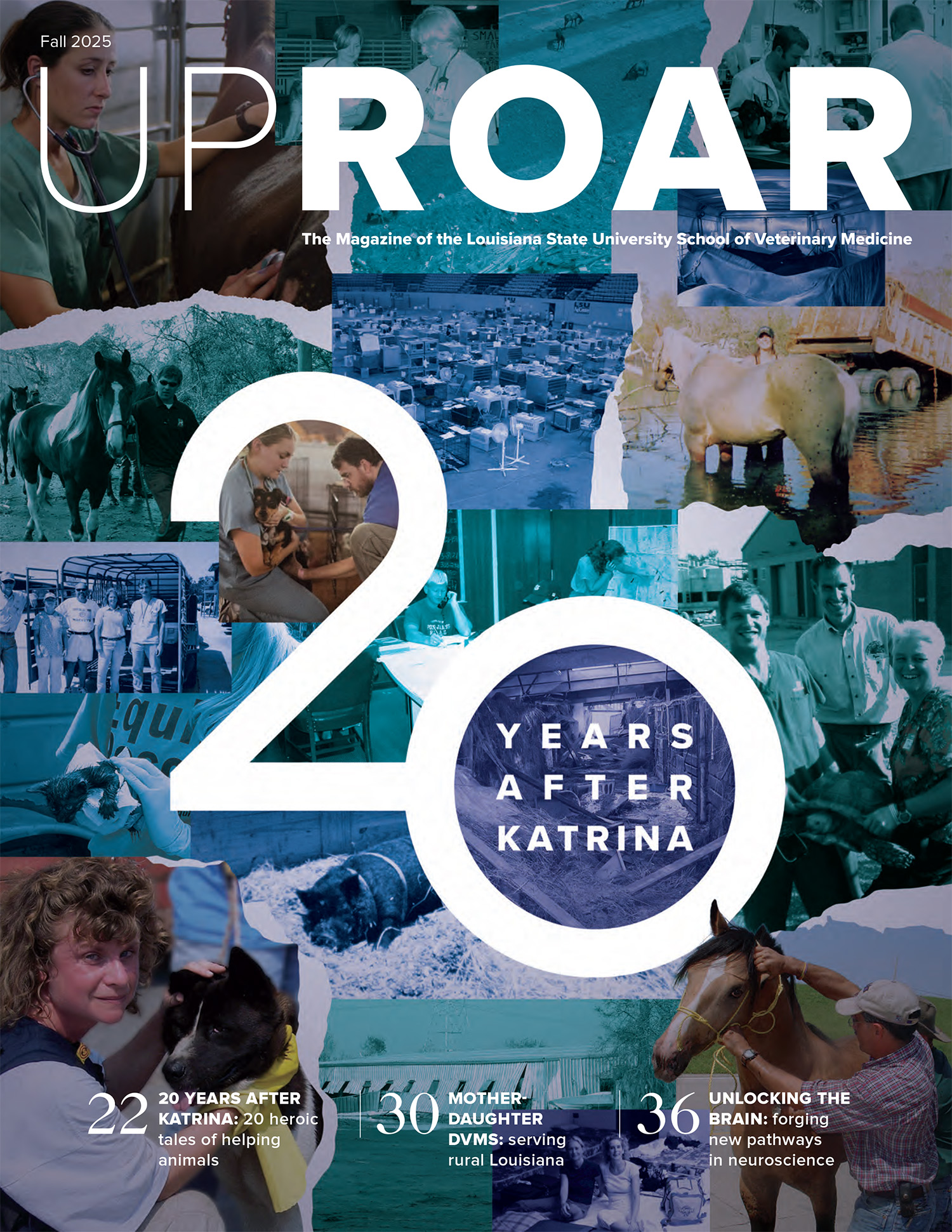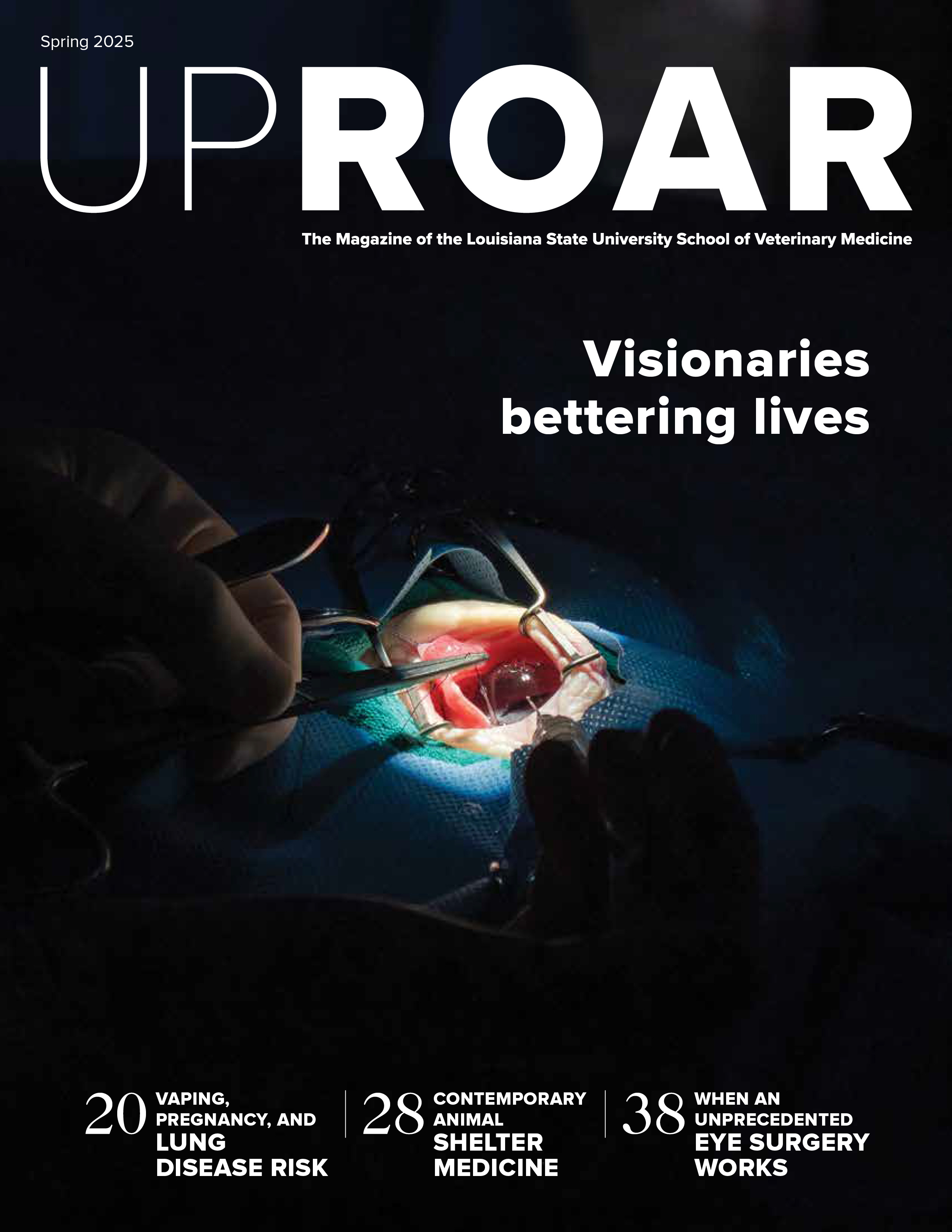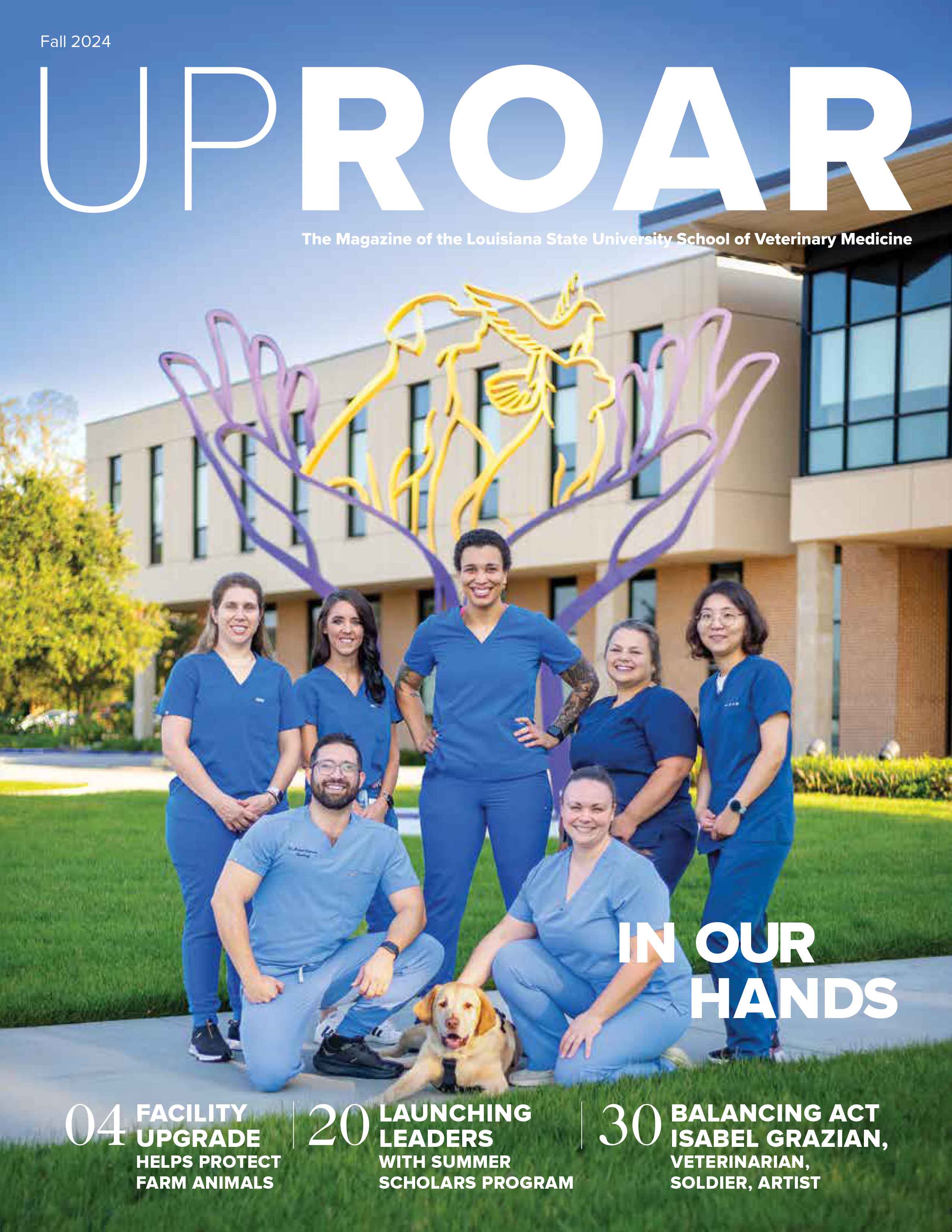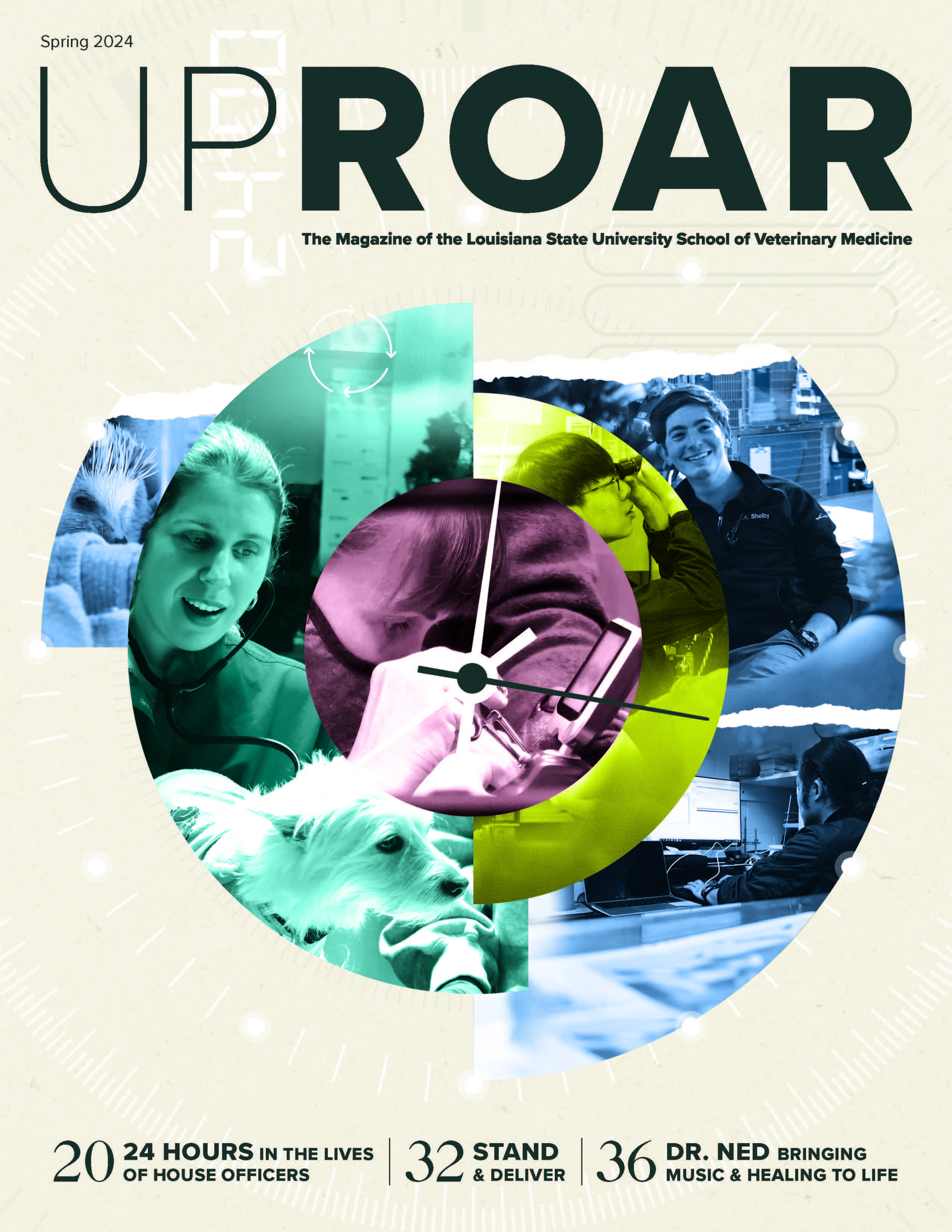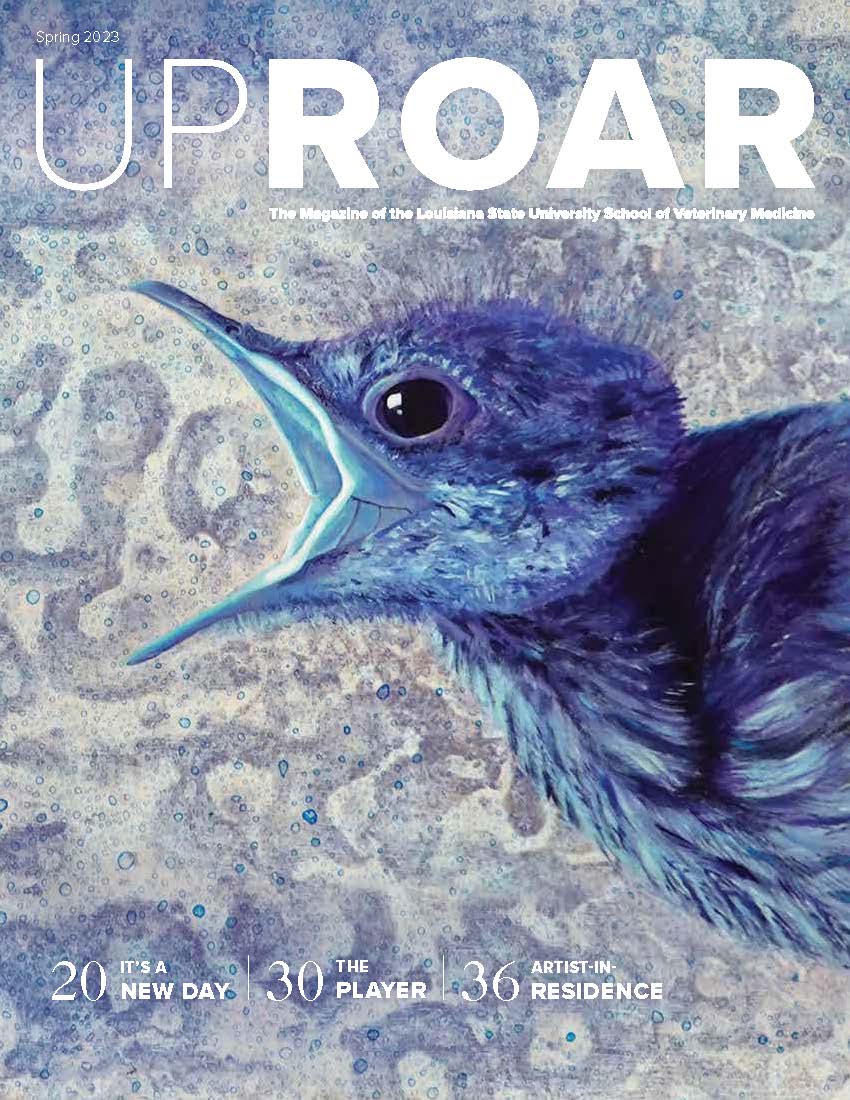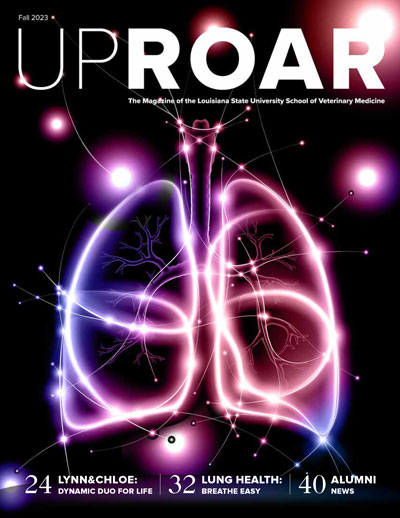Publications
UPROAR, the magazine of LSU School of Veterinary Medicine, presents stories that bring to life our teaching, healing, discovering, and protecting missions. The magazine is published twice per year, in the spring and fall. You can view the digital editions by clicking on the covers below. Alumni news and story suggestions may be submitted to Sandra Sarr at sarr1@lsu.edu.
Vaping, pregnancy, and lung disease risk: Dr. Noël leads NIH-funded research in a quest to improve public health
Dr. Alexandra Noël is on a mission to conduct fundamental research to help improve public health in Louisiana and beyond, uncovering how vaping during pregnancy affects the respiratory health of both mothers and their offspring. Her groundbreaking research is paving the way for better understanding, prevention and treatment of potential lung diseases following gestational exposures to vaping products.
At the forefront of contemporary animal shelter medicine
Tanner Hernandez never planned to become a veterinarian. Growing up on a rural Louisiana farm, he wanted to be a teacher like his mother. Now, the 2020 LSU School of Veterinary Medicine graduate is both—and more. As medical director at Companion Animal Alliance (CAA), a non-profit open-intake shelter for East Baton Rouge Parish, Louisiana, he is a leader in contemporary shelter medicine, a profession that wasn’t fully recognized as an official veterinary specialty until March 2023 by the American Veterinary Medical Association’s American Board of Veterinary Specialties. He is one of the youngest medical directors serving one of the largest animal shelters in Louisiana.
Arturo Otamendi, Summer Scholar 2011, DVM 2014, DACVIM
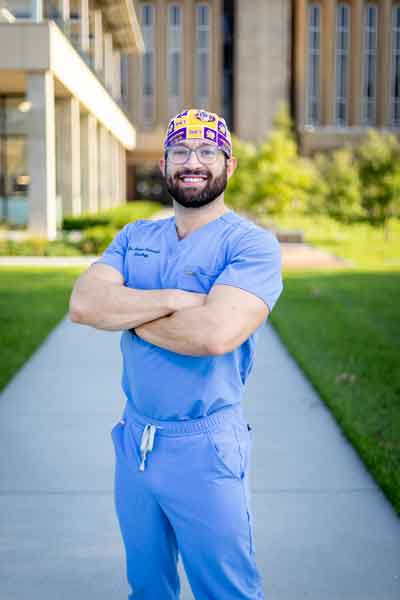
Dr. Arturo Otamendi
Arturo Otamendi remembers finding a litter of kittens covered in worms and wounds while on his grandparents' farm in Venezuela. He brought them inside, bathed them, and applied medicine and bandages. He was 6 years old. He is still helping animals and teaching others to do so at LSU School of Veterinary Medicine as a board-certified veterinary neurologist specializing in diagnosing and treating conditions affecting the brain, spinal cord, nerves, and muscles, often helping paralyzed pets to walk again.
"Medicine is fascinating. As a veterinarian, I combine science and my love of animals. Both have to be in my life," said Arturo, who came at age 9 to the U.S. from Venezuela with his mother and brothers. He is not the first in his family to enter the medical profession. His mother runs multiple pre-clinical studies and was an ER doctor for humans in Venezuela. His grandfather is a dermatologist in Venezuela and completed his residency at Harvard.
Valedictorian of his graduating class at East Jefferson High School in Metairie, La., his longstanding passion for animals, including wildlife, led him to volunteer at Audubon Zoo during summer breaks.
In 2011, during Arturo's second year at LSU School of Veterinary Medicine, he participated in the Summer Scholars Program with Dr. Joseph Francis, professor in the Department of Comparative Biomedical Sciences, as his mentor. Together they worked on a project entitled, “Mechanism by which exercise training decreases blood pressure: role of sirtuins.” Sirtuins play a large role in neurodegenerative diseases and inflammatory diseases in the central nervous system. He published a paper and presented his research at Phi Zeta Research Emphasis Day, where he gained practice presenting. The project opened his eyes to a whole new world in science.
"The Summer Scholars Program changed the trajectory of my career. It helped me get my foot in the door and showed that I had research experience," he said.
During his fourth year at LSU Vet Med, he did an externship at the Schwarzman Animal Medical Center, New York City's only Level 1 Veterinary Trauma Center. He assisted in the surgical removal of a brain tumor in a cat, and that's when he became interested in neurology. A rotating internship at North Carolina State University solidified his decision to specialize.
He practiced veterinary neurology in San Francisco, Calif., and New Orleans, La., before returning to LSU Vet Med in early 2024 as an assistant professor of neurology and neurosurgery.
Arturo’s research interests include cognitive and behavioral changes in dogs and cats associated with age, quality of life implications for patients with canine cognitive dysfunction, histological age-related changes to the brain, neoplastic disorders affecting the brain and spinal cord, and neurodegenerative diseases. Clinically, he specializes in managing complicated seizure cases and patients with inflammatory diseases of the central nervous system.
"I always knew I wanted to specialize, and LSU Vet Med's Summer Scholars Program made my path easier. If I hadn't done it, it would have taken me longer to reach my goals," he said.
In 2018, he completed a neurology residency at Texas A&M University. Securing such a residency is extremely competitive. There are only 15 neurology residency spots in the entire U.S. During interviews, the first thing he heard was, "Tell us about your research." He said, "It really made me stand out from the crowd."
"Arturo was inquisitive and eager to learn. It was like watching a light bulb turn on. I am proud of him, but I don't take any credit for his success," said mentor Dr. Francis, neuroscientist, cardiovascular expert.
"So many people helped me get to where I am today," Arturo said.
Several veterinarians have taken Arturo under their wing and mentored him. One was
Dr. Jon Fletcher, director of Post-Graduate Medical Education & Clinical Studies at
MedVet in Mandeville, La. A challenging case that stands out for Arturo is that of
Blue Jay, a beautiful Labrador retriever who'd been having seizures. An MRI indicated
encephalitis, inflammation of the active tissues of the brain caused by an infection
or an autoimmune response. The inflammation caused the brain to swell, which led to
seizures in the dog.
"He was deteriorating, comatose, and not responsive. Someone said that we may need
to euthanize. I said, 'Let's try one more thing.'"
They administered an IV with a chemotherapy infusion of Cytoxan, which reduced the
inflammation of his brain. The dog improved and was walking after three days. Blue
Jay didn't have any more seizures.
"I love saving an animal from the brink of death. There always can be a little hope," he said, adding, "I thoroughly communicate with clients and present treatment options in ways that they understand. I take the time to build trust. In the end, it is important to respect the clients' decision. We are here to present options."
After leaving MedVet and joining LSU Vet Med, Arturo said he's doing what he loves, especially teaching. He delights in seeing students' passion for learning when they cycle through the Neurology service in LSU Vet Med's Veterinary Teaching Hospital, where he is a member of a stellar team.
"It was always my end goal to return to LSU Vet Med. I love to teach. It comes naturally. I want students to feel comfortable seeing neurology cases and to get them thinking like doctors. I not only care about the learning but also about their wellbeing. I know the stresses of veterinary school and teach with compassion," said the assistant professor of neurology and neurosurgery.
The Neurology team schedules time regularly for students to discuss wellness issues
and meet with the school's wellbeing manager. Arturo checks in with his students on
how they manage stress.
"For me, it's through music," he said. He played trombone in a marching band, orchestra,
and jazz band. For seven years, he didn't play at all and then joined a community
band in San Francisco. Long fascinated with the bassoon, he rented one for $50 a month
and watched YouTube videos to teach himself how to play. "It's so melodic and has
lots of options for making beautiful sounds," he said. For six months, he practiced
every day, auditioned, and joined the New Orleans Civic Orchestra. Now, he plays with
the Civic Orchestra of Baton Rouge, plays trombone in the Tiger Rag Tag Band (comprised
of LSU Tiger Band alumni), and participates in several public performances throughout
the year.
"Whenever I get excited about something, I try very hard," Arturo said. "Mentors helped me become who I am today. Now I get to be that person for someone else," he said.
2024 Summer Scholars, Mentors, Research Projects
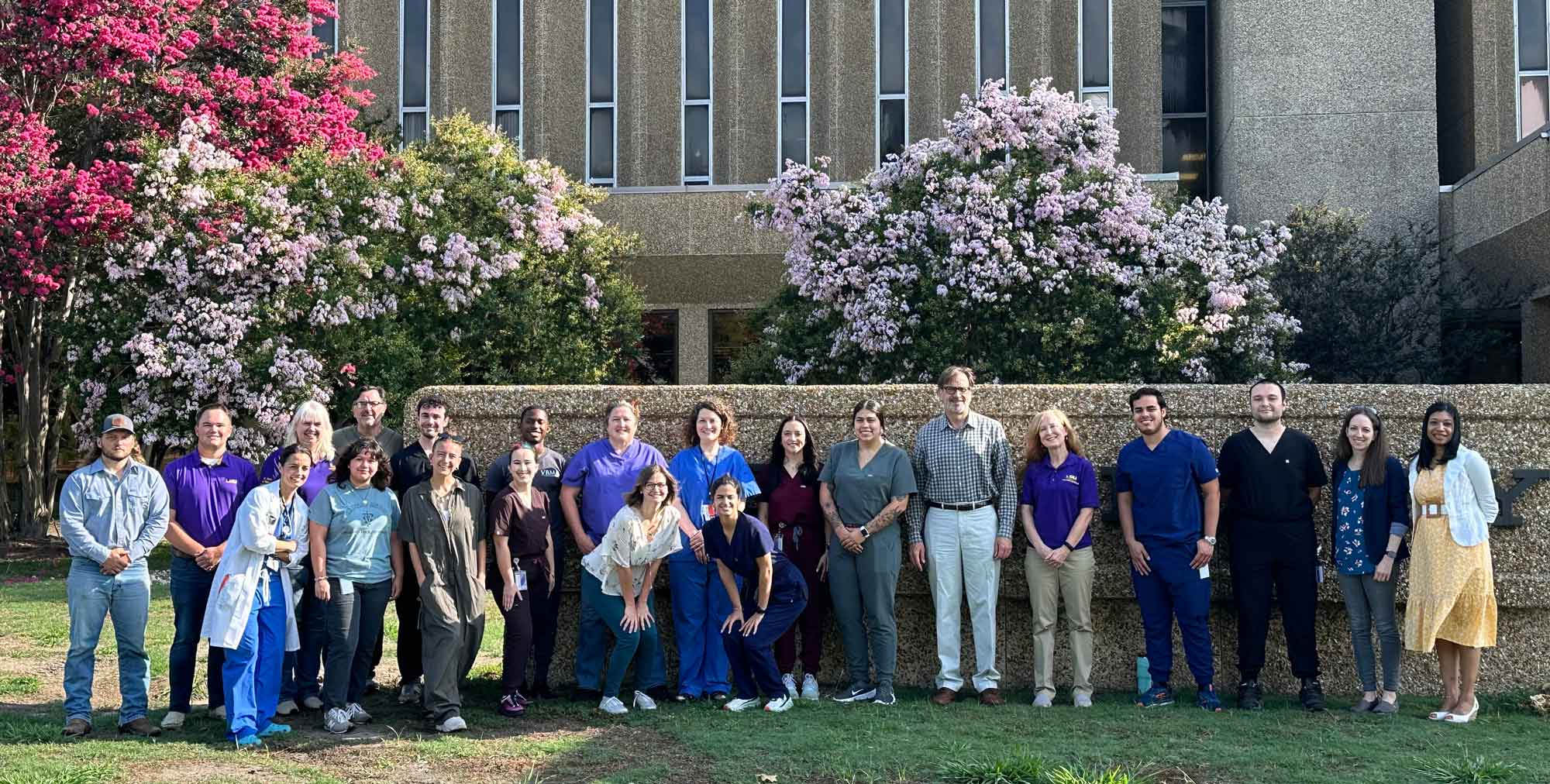
2024 Summer Scholars students and mentors
Casey Anderson is working with Dr. Adriano Vatta, associate professor of parisitology, on the proposal titled, “Clinical evidence of anthelmintic failure: a retrospective investigation into small ruminant patient records at the LSU Veterinary Teaching Hospital.”
Rhiannon Ballard-Davis is working with Dr. Kielyn Scott, Associate Clinical professor of Integrative Medicine and Rehabilitation, on the proposal titled, “Using Targeted Pulsed Electromagnetic Field Therapy to decrease anxiety in Captive Wolf Hybrids.”
Sarah (Peyton) Cagle is working with Dr. Brooke Dubansky, Associate Professor of Anatomy, on the proposal titled, “Utilization of contrast-enhanced CT imagining to characterize ligamentous and tendinous osteoderm attachments in the American Alligator (Alligator mississippiensis).”
Austin Dykas is working with Dr. Mustajab Mirza, Associate Professor of Equine Surgery, on the proposal titled, “One-Layer Closure of Small Intestinal Resection and Anastomosis in Adult Horses.”
Thomas Harris is working with Dr. Noelia Diaz Falcon, Clinical Assistant Professor of Anesthesiology, Dr. Mark Mitchell, Professor of Zoological Medicine, and Dr. Jeannette Cremer, Associate Professor of Veterinary Anesthesiology. Thomas’ proposal is titled, “Can Indirect Blood Pressure Monitoring be Used in Birds: Measuring the Level of Agreement Between Indirect and Direct Arterial Blood Pressure Methods in Sedated Barred Owls (Strix varia).”
Carolina Inturregui is working with Dr. Pilar Camacho-Luna, Assistant Professor of Veterinary Ophthalmology, on the proposal titled, “Evaluation of circadian variations of central corneal thickness and its correlation with intraocular pressures in healthy horses.”
Ethan Neal is working with Dr. Mark Mitchell, Professor of Zoological Medicine, on the proposal titled, “Determining the Pharmacokinetic Properties of Two Different Doses of Oxfendazole in Barred Owls (Strix varia).”
Sara Bucher is working with Dr. William Beavers, Assistant Professor in the Department of Pathobiological Sciences, on the proposal titled, “Envelope targeting antibiotics induce arachidonic acid resistance in Staphylococcus aureus.”
Ralph Delgado is working with Dr. Mandi Lopez, Director and Professor of the Laboratory for Equine and Comparative Orthopedic Research, on the proposal titled, “Regeneration and Cryopreservation of Tendon Neotissue for Equine Tendon Healing.”
Julia Harig is working with Dr. Ahmed Abdelmoneim, Assistant Professor in the Department of Comparative Biomedical Sciences, on the proposal titled, “Effects of Developmental Exposure to Diethylhexyl Phthalate on Organismal Development and Behavioral Stress Response.”
Genesis Mize is working with Dr. Basel Abuaita, Assistant Professor of Infectious Diseases, on the proposal titled, “Comparative horse macrophage host-defense against Salmonella serovars.”
Solomon Pearson is working with Dr. Alexandra Noël, Assistant Professor in the Department of Comparative Biomedical Sciences, on the proposal titled, “Impact of e-cigarette nicotine chemical form, tobacco derived vs. non-tobacco derived, on pulmonary responses in mice.”
Logan Roddy is working with Dr. Henry Green, Associate Dean for Opportunity and Engagement and Associate Professor of Veterinary Cardiology, Dr. Wendy Wolfson, Associate Professor of Shelter Medicine and Surgery, and Dr. Krista Miller, Assistant Professor of LSU/PetCo Love Community Outreach. Logan’s proposal is titled, “Prevalence of Clinical Signs in Canines Affected with Trypanosoma Cruzi Infections Amongst Various Southern Louisiana Parishes.”
Diagnostic lab is often first line of defense in animal, human disease threats
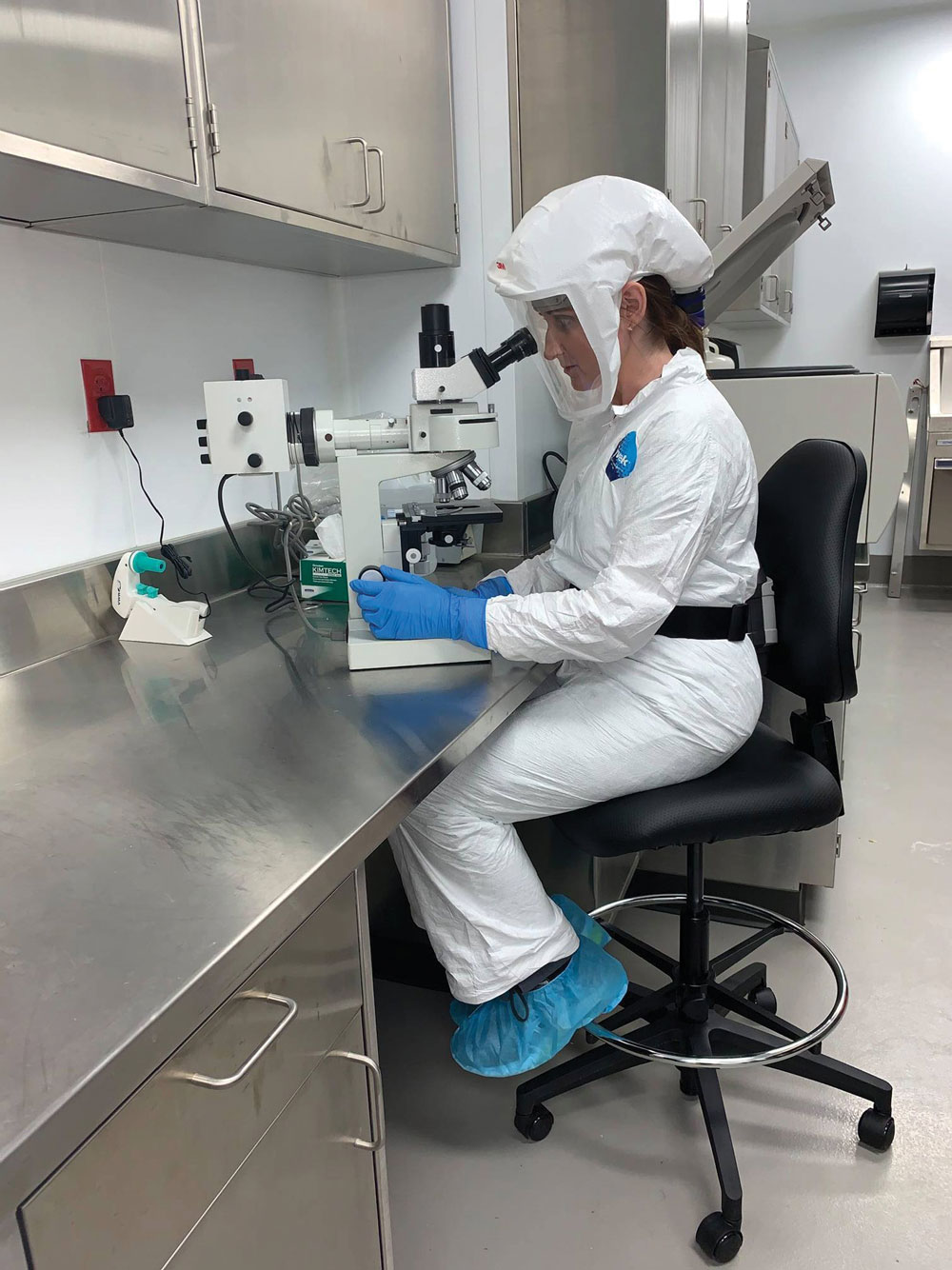
As a diagnostic testing service provider located directly on the campus of LSU Vet Med, the Louisiana Animal Disease Diagnostic Laboratory (LADDL) has played a crucial role in protecting Louisiana from animal and human disease outbreaks. The acceleration of deadly pathogens such as COVID-19, unexpected outbreaks of animal disease affecting Louisiana wildlife, and the need for expanded services such as forensic pathology have broadened LADDL’s portfolio of protection.
In animal health, detecting outbreaks of Chronic Wasting Disease (CWD) in statewide deer populations has protected the safety of hunters in Louisiana. LADDL collaborates with Louisiana Department of Wildlife and Fisheries to identify possible cases of CWD. The first confirmed case of CWD in Louisiana for the 2022-23 hunting season was detected by LADDL in January 2022.
When COVID-19 outbreaks applied pressure upon state health organizations to provide quick and accurate testing to identify and control the spread of the SARS-CoV-2 virus, LADDL established a CLIA laboratory with a certificate of compliance for testing human specimens. This enabled LADDL to test LSU students, staff, and faculty for COVID-19. More recently, the team of scientists at LADDL developed reliable testing for the Monkeypox virus as infections began to rise across the country.
Dr. Udeni Balasuriya, Director of LADDL since 2018, has overseen the evolution of the laboratory as a service provider that reacts swiftly to the changing needs of animal and human healthcare.
“LADDL has always partnered with veterinarians, commodity groups, and health organizations in Louisiana and across the country to test clinical specimens during animal disease outbreaks, but the rapid spread of pathogens such as SARS-CoV-2 in human populations has required us to think innovatively and react quickly,” said Dr. Balasuriya. “We have so much experience with many infectious diseases in the animal. It was natural for us to apply that expertise to combat human disease outbreaks.”
Putting a new spin on old drugs
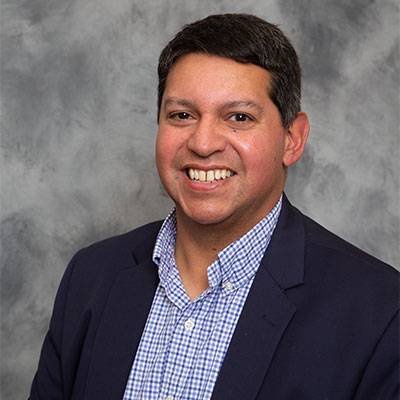
Pharmaceutical companies have not developed new classes of antibiotics over the last several years and at the same time, the over prescription of antibiotics may be contributing to the rise of drug-resistant bacteria. As a result, researchers at LSU are exploring new ways to combat illness. Instead of attacking the virus, bacteria, or parasite, they are looking at FDA-approved drugs that make the human body inhospitable to certain diseases. On May 30, Professor Juan Martinez shared findings from his research in this area as part of the LSU Science Cafe series at the historic Varsity Theatre at the North Gates of the LSU campus.
Juan Martinez, PhD, professor of Pathobiological Sciences and director of graduate education, is laying the scientific groundwork to tackle the persistent problem of bacteria that cause diseases that are unable to be treated with traditional medications. As part of the LSU School of Veterinary Medicine’s Department of Pathobiological Sciences, part of Dr. Martinez research endeavors is focused on finding alternative strategies to combat certain classes of disease-causing bacteria. He has covered a wide range of biomedical research, including an investigation of tick-borne diseases funded by the National Institutes of Health and the National Institute of Allergy and Infectious Diseases.
His lab’s work is understanding how bacteria cause disease and at the same time expanding the arsenal to combat some of the most difficult infections plaguing humans and other animals. Born and raised in Chicago’s predominantly Mexican immigrant neighborhood La Villita, Dr. Martinez’s fascination with the inner workings of things drew him to the field of science. He earned a Ph.D. in microbiology and microbial pathogenesis from Washington University in St. Louis, Missouri, and spent four years as a post-doctoral research scholar at the Institut Pasteur in Paris, France. Prior to his arrival at LSU, he was a tenure-track faculty member in the Department of Microbiology at the University of Chicago.
Dog Daycare Debuts with Howling Success
LSU Vet Med Dog Daycare Center officially opened in August with a celebratory gathering
involving tours and treats for all. 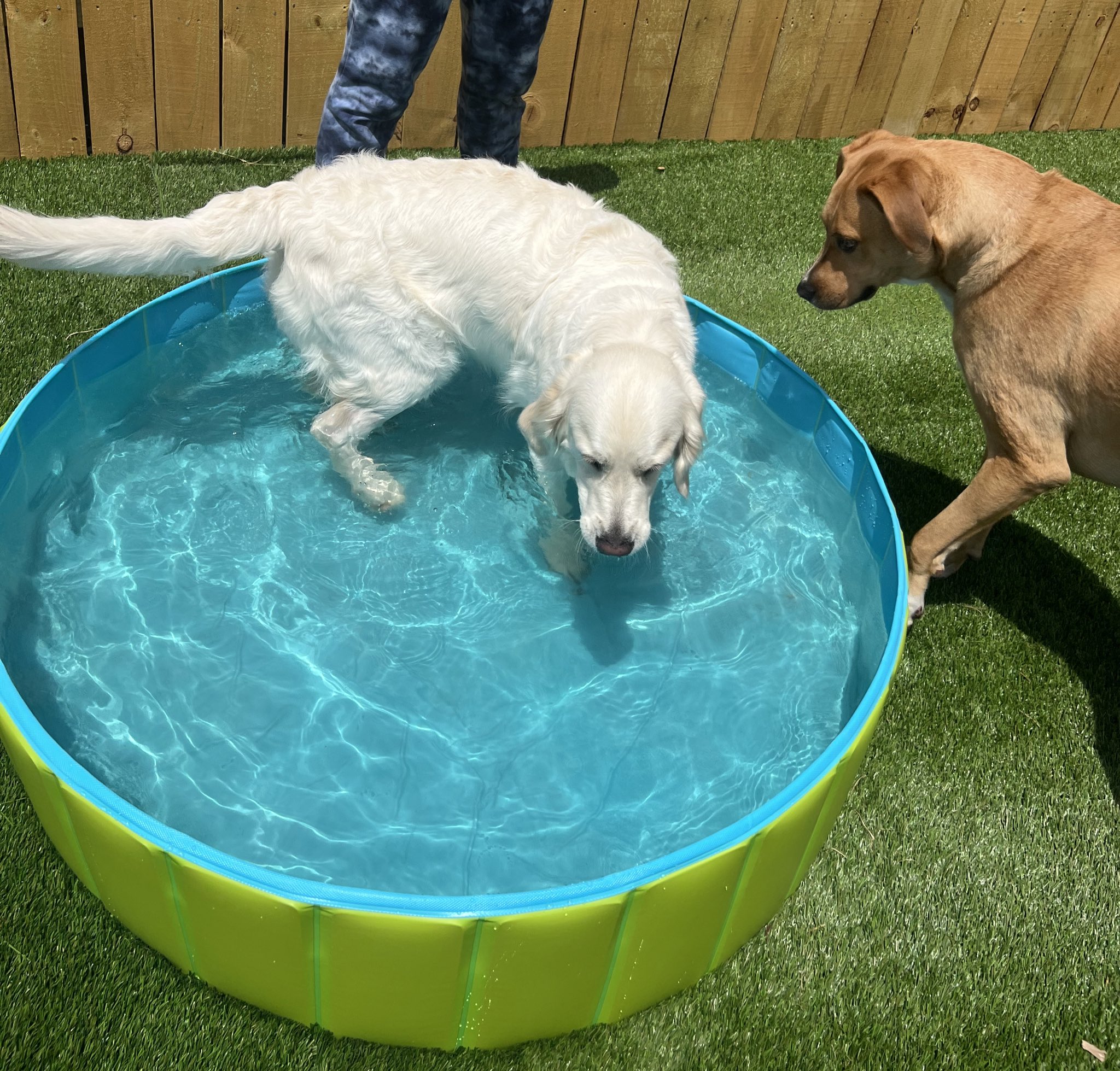
Nearly a dozen dogs were signed up by their owners for the first week of daycare with plenty of fun, enrichment activities, and supplemental training taking place.
The daily schedule begins with breakfast and potty walks followed by one-on-one activities with staff and dogs. Then comes lunch, indoor activities such as puzzle toys, lick mats, and meeting other dogs in groups of three or four with three staffers on hand. Afternoons bring outdoor activities, including a wading pool and splash pads, followed by potty walks, and individual kennel time for rest and naps. Owners receive fun daily “report cards” on how their dogs did throughout the day.
Heading up the Dog Daycare Center is Destiny Stuart, who has more than 13 years of combined animal care and grooming experience. Her full-time staff include Liz, with 20 years of dog training experience, and Jessica, with a combined grooming and daycare experience of six years. Eight student workers assist and more are expected to be hired as business increases.
“Pets are getting personalized care. It’s really touching to see certain dogs come out of their shell here. We always go the extra mile to make sure dogs get the most out of their experience,” Destiny said. Offering an array of services for LSU Vet Med faculty, staff, and students, the Center is open 7 a.m. to 7 p.m. weekdays and currently can accommodate up to 38 dogs. Dogs are monitored by at least one staff member at all times, with emails and text updates for owners throughout the day. Pricing packages include discounts for those registering for multiple days.
The facility is equipped to provide full-service grooming, two outdoor securely fenced yards with shade canopies, and spacious indoor play areas and kennels.
Dog owners fill out an application that provides information about their pets, including physical and behavioral needs, temperament, and preferences. Proof of all current vaccines and preventatives are required.
“We’re also well equipped to handle special needs dogs,” she said.
Destiny, Dog Daycare Center coordinator, can be reached at (225) 334-1312 or via email at dstuar2@lsu.edu.
Rangasamy wins science and innovation award for discoveries that could lead to new treatments for deadly lung diseases
Dr. Tirumalai Rangasamy, associate professor of research at the Center for Lung Biology
and Disease, Department of Pathobiological Sciences, was named 2023 Science and Innovation
Center Abstract Award winner for his scientific abstract on secondhand cigarette smoke
by the American Thoracic Society (ATS) Assembly on Pulmonary Infections and Tuberculosis
Award Selection Committee.
ATS 2023 showcases the latest advances and discoveries in respiratory science, patient care, and global respiratory health. The ATS International Conference is the gathering place for pulmonary, critical care, and sleep professionals, ranging from those in the early stages of their careers to those who have gained international recognition for their research or clinical care advancements. Every year, approximately 14,000 of these professionals attend, present, and learn about the latest advances, while also connecting with colleagues from around the world and forging new collaborations.
“It is truly the convergence of today's science with tomorrow's care, which is especially important because Chronic Obstructive Pulmonary Disease is the third leading cause of death and is killing nearly 5 million people each year. There are no effective treatments,” said Dr. Rangasamy, who delivered a presentation at the Walter E. Washington Convention Center in Washington, D.C., in May.
Under the mentorship of Dr. Samithamby Jeyaseelan, Dr. Rangasamy's research focuses on chronic obstructive pulmonary disease, allergic asthma, acute lung injury, septic shock, and pneumonia caused by various bacterial species.
Tobacco smoking is responsible for over 70 percent of COPD cases in high-income countries. COPD can be complicated by frequent exacerbations triggered by bacteria, viruses, and environmental pollutants.
In 2019 alone, it was estimated that there were 4.95 million deaths associated with superbugs. There is currently no effective therapy available for treating patients with COPD or COPD exacerbations. Dr. Rangasamy and his colleagues have developed a novel model of COPD-associated bacterial exacerbations, specifically focusing on the mechanisms by which CRKP superbug causes exacerbations in mice with pulmonary emphysema induced by secondhand cigarette smoke.
“Because of the infection, the lungs cannot expand and contract, which inhibits breathing and can lead to death,” he said.
He has published numerous articles in international journals, presented his research at more than 45 national and international conferences, and serves on the editorial board of three scientific journals, including Frontiers in Immunology. He is valued member of the Science Advisory Board and is an honorary member of London Journal Press. Dr. Rangasamy is an Investigator/Co-investigator for more than 12 NIH-funded grants, and his dedication to scientific research have earned him over 14 national and international awards, including the prestigious Lasker Fellowship.
“I am grateful that my scientific research over many years can be useful in helping to alleviate suffering and save lives,” Dr. Rangasamy said.
Sustainability Advocates and Veterinary Environmentalists (SAVE)
The Sustainability Advocates and Veterinary Environmentalists (SAVE) Committee pledges to establish and consistently maintain a professional and academic community upheld by sustainable environmental practices. Our role is to provide awareness and continuing education throughout the region, and to reduce our carbon footprint here at the Louisiana State University School of Veterinary Medicine (LSU Vet Med).
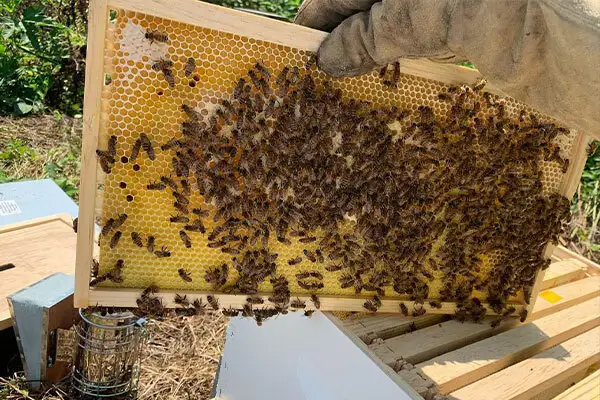
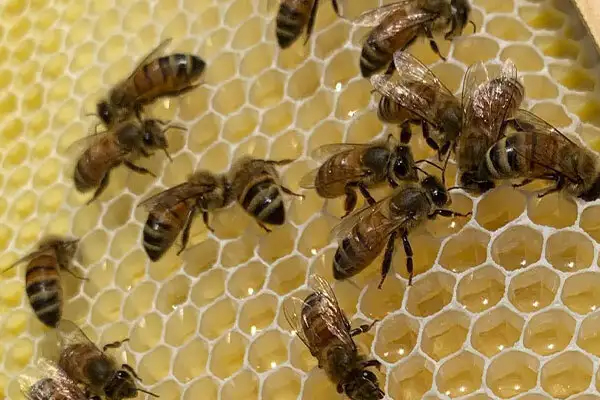
So far, SAVE activities have included establishing an LSU-based Honey Bee Veterinary Consortium (HBVC) Club, hosting information tables for membership, education, and fundraising, starting a composting partnership with 3 Little Pigs cafeteria, collecting food waste for composting, installing reflective stickers on upper-level Vet Med building windows to reduce mid-flight crashes into windows, successfully applying for a Student Sustainability Fund grant from the LSU Student Campus Sustainability Fund to start a Black Soldier Fly Larvae project, going on a fact-finding mission to Republic Recycling in Baton Rouge, participating in the LSU Lakes Kayak Cleanup event. Planned events include making a plant pollinator garden and hosting a public forum on recycling.
The Student Chapter of the Honey Bee Veterinary Consortium is part of the HBVC, which is made up of students and professionals from all segments of veterinary medicine and animal science who care about bees and beekeeping. SAVE experienced an abundant honey harvest from its Italian honey bees. Two gallons of delicious honey were collected.
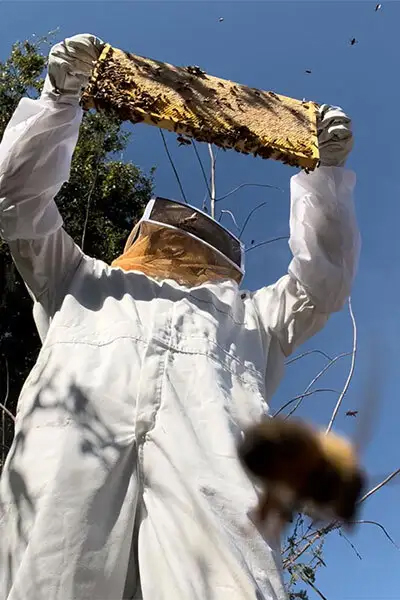
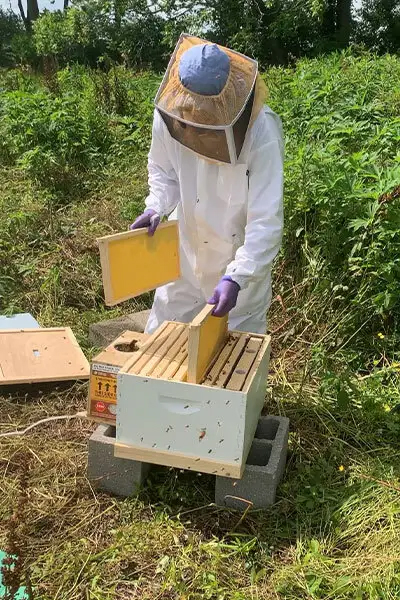
The group aims to foster connections between animal health, human health, and environmental
health and reduce LSU Vet Med's carbon footprint.
SAVE accomplishes its goals through working groups:
- Honey Bees: Working with Southern Italian Honey Bees near the LSU Vet Med campus to incorporate bee husbandry, medicine, and care into the curriculum
- Recycling: Collecting various forms of plastics and having appropriate locations for making reuse more accessible for LSU Vet Med (not limited to just plastic but also includes all aspects of reduce, reuse, recycle (e.g., thrifting, paper, etc.).
- Food Waste: Reducing food waste at LSU Vet Med by utilizing a composting program with Fluker Farms and by collaborating with 3 Little Pigs, LSU Vet Med's dining hall
- Outreach and Advocacy: Working with SAVE in efforts to involve the community in educating about sustainability through social media, lectures, and events
The SAVE Executive Board is comprised of LSU Vet Med students, staff, and faculty: Taina Rodriguez, Ashlee Lineberger, Lucy Barre, Kimberly Boykin, Mark Mitchell, Bonnie Brocato, and Brian Collins.
Vanessa Wolf: Preparing Service Dogs for Their Roles
Vanessa Wolf is a veterinarian with a heart committed to making a difference in the lives of children and veterans with disabilities. Her journey with 4 Paws for Ability began in August 2020 when she joined the non-profit organization based in Xenia, Ohio. As an Associate Veterinarian, Vanessa plays a pivotal role in the journey of task-trained service dogs, overseeing their health and well-being from puppyhood to their life-changing roles as companions and helpers.
At 4 Paws for Ability, approximately 120 service dogs are placed with deserving recipients
each year. Vanessa is at the forefront of ensuring these dogs are well-prepared for
their roles. The organization primarily utilizes breeds like Golden Retrievers, Labrador
Retrievers, Goldendoodles, and more. Vanessa's responsibilities encompass diverse
aspects of veterinary medicine, from supervising the breeding process to overseeing
artificial inseminations, and monitoring the health and growth of the litters. Her
expertise extends to collaborating with
local veterinary clinics for surgeries, dentals, and radiographs, ensuring the overall
health and well-being of these remarkable animals.
Vanessa's impact goes beyond the medical realm. She is an essential part of a multidisciplinary team that collaborates closely with trainers during the Advanced Training phase. This phase is a critical step in preparing the dogs for their specialized tasks, such as behavior disruption, seizure alerts, mobility assistance, and more. Witnessing the progress of these dogs and the transformative impact they have on the lives of those they serve is a driving force for Vanessa's unwavering commitment. Her dedication to service dogs' health, development, and transformation exemplifies the profound impact that veterinary professionals can have on the world. Through her work, Vanessa embodies the organization's mission of enriching lives, one service dog at a time.
Harnessing the Power of Music for Wellness
New songs and research topics flow from artist’s residency
By Sandra Sarr
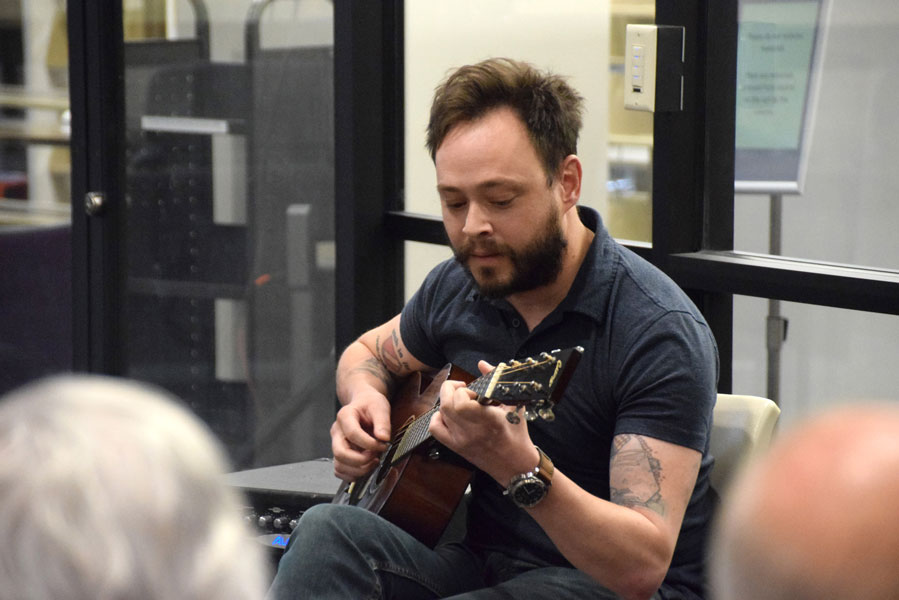
“Art in its varied forms is an avenue for teaching, healing, discovering, and protecting and greatly enhances what we do at LSU Vet Med.” —Dean Oliver Garden
On a Tuesday night in September, nearly 100 guests from New Orleans to the east and
Lafayette to the west arrived at LSU Vet Med—some for the first time—for our Artist-in-Residence
Concert featuring musician-composer Charlie Rauh. Some had read stories in the media
and were intrigued by the notion of an artist in residence at a veterinary school.
Others had invited Charlie into their treatment rooms and their sphere of trust, where
he steeped himself in the world of clinicians and their patients and made music not
only for them, but of them.
The evening concert vibrated with the mesmerizing sounds of 12 songs Charlie composed
born of his interactions with clinicians, animals, and researchers, including four
songs sung with sensitivity and power by members of the LSU A Cappella Choir under
the direction of Dr. Alissa Rowe.
“The songs he composed arose from deep within the heart of LSU Vet Med in relationship
with our people and the patients and clients we serve. New music, interdisciplinary
connections, and exploratory pathways to wellness were generated during this residency,”
said Sandra Sarr, who manages the Artist-in-Residence Program.
The 2023 residency explored how music contributes to the wellbeing of both animals
and people. Charlie often could be found playing his guitar softly during treatment
sessions with patients and clinicians, which appeared to create a soothing atmosphere
for both.
“It’s been fun to see the response of some of the animals when they hear Charlie’s
music while we’re treating them. Charlie would know what tunes they were responding
to.
They kind of figured out what he was doing, interacted with him, and then started to relax,” said Dr. Kailyn Scott, associate clinical professor of Integrative Medicine and Rehabilitation.
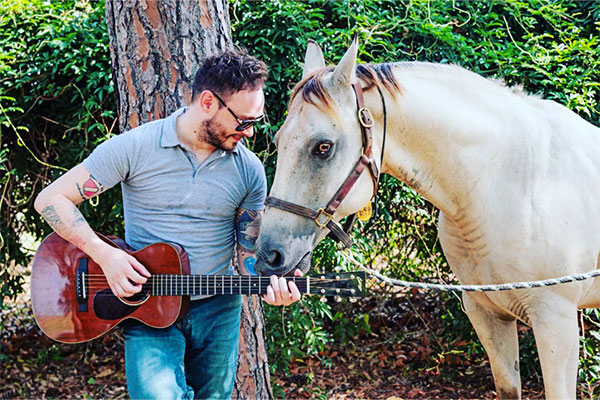
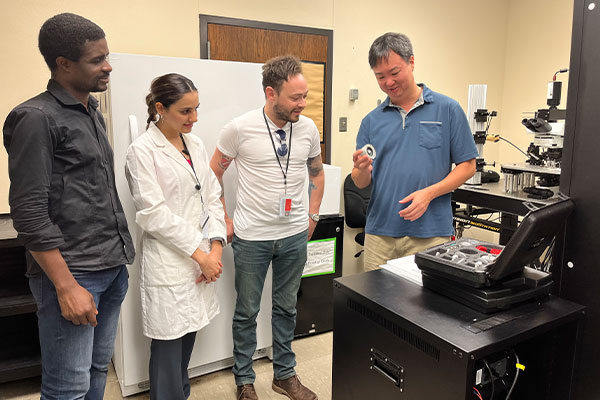
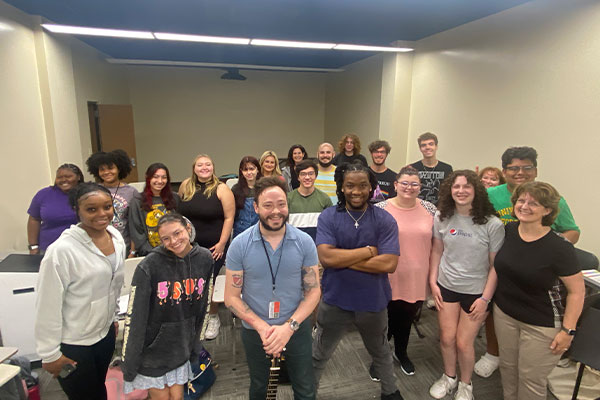
For five weeks spanning August and September, Charlie observed our clinicians in action
in the Large Animal Hospital, the Wildlife Hospital, Neurology, Oncology, Cardiology,
Emergency & Critical Care, Research Labs, Community Practice, Integrative Medicine,
Anatomy, Ophthalmology, and Osteopathy. Initial meetings with clinicians that occasionally
began tentatively always concluded with enthusiasm and willingness to explore what
music might add to wellness efforts at the vet school.
The effects of music on wellness have been well documented in humans, and studies
with domestic and other animals have revealed that music also has a powerful effect
on them, according to Dr. Susan Wagner, veterinary neurologist and co-author of Through
a Dog’s Ear.
Sparked by this residency, discussions are taking place among LSU faculty in Integrative
Medicine, Music Therapy, and Neurology about potential ways to expand and measure
the efficacy of music and wellness in animals.
“I hope that this translation through sound is received as a witnessing.” —Charlie Rauh
Engaging the LSU community across disciplines was an important aspect of the 2023
residency with the of the School of Music, just as it was with the School of Art for
the 2022 residency.
Dr. Eric Lau, Dean of the College of Music and Dramatic Arts, said during his opening
remarks at the concert, “This world premiere performance is something very special.
It is rare to see the composer and the musicians on the same stage performing together,
and it is an exciting and enriching opportunity for our students to be able to work
directly with the composer on the first performance of this beautiful music. We are
so excited about this collaboration with the vet school.”
Charlie also helped connect LSU Vet Med across campus by making guest appearances
in the classrooms of Dr. Kamile Geist, associate professor of music therapy and Ava
& Cordell Haymon Endowed Chair, Dr. Alissa Rowe, associate professor and Galante Director
of Choral Studies, and Dr. Christine Cloud, LSU Libraries Special Collections and
English literature honors instructor. Charlie’s music, up until now, had been inspired
by literature, including that of the Brontës, Phillis Wheatley, and Anne Morrow Lindbergh.
Giving his all throughout the residency, Charlie performed weekly Music at Noon, playing
guitar music for faculty, staff, and students to enjoy during their lunch breaks.
He accepted every invitation, including Dr. Rebecca Christofferson’s to join her at
8 a.m. visit to jazz pianist Bill Evans’ gravesite where she collects insect specimens
in the cemetery for her research. He even played his guitar at the request of Anatomy
professors wanting to ease the stress of new students as they practiced hands-on techniques
in the lab.
“It was a chance of a lifetime to clearly look at the elements that make all life
worthy of protection, care, and healing,” Charlie said.
His song collection, Theoria, will be released by Destiny Records this fall. LSU Vet
Med has permission to utilize the music however we wish—in waiting rooms, treatment
rooms, in our videos, for student listening at their leisure. Let the music play on
for the good of all.
Breathe Easy: Researchers relentlessly pursue solutions to lung disease to help people breathe easier and live longer
By Sandra Sarr
There is no yesterday in your lungs
there is no tomorrow either
there is only now
there is only inhale
there is only exhale
there is only this moment
—excerpted with permission from a poem by John Roedel
The function of lungs is a subject most take for granted since breathing does not require thought. Our lungs usually do their job effortlessly and reliably. When they don’t or can’t, medical intervention becomes necessary. Breath is essential to life. And when available medical interventions do not offer sufficient relief, new discoveries become a lifeline.
At the Center for Lung Biology and Disease (CLBD), a Center of Biomedical Research Excellence (COBRE) at LSU School of Veterinary Medicine, some of the best and brightest minds are taking aim at all manner of life-threatening respiratory diseases, including bacterial and viral lung infections, asthma, and acute lung injury. Backed by more than $11.5 million in funding from the National Institutes of Health, the CLBD has proven itself a true center of excellence where discoveries are in progress to alleviate human suffering.
Lung diseases are an increasing problem, especially in babies, the immunocompromised and the elderly. Louisiana is among the top five states most affected by pulmonary diseases. The overarching goal of the CLBD is to gain new insights into the pathogenesis of devastating lung diseases that will guide improved strategies to treat and prevent lung diseases in humans.
A powerful contributor to LSU Vet Med’s discover mission, the CLBD augments research on campus in the molecular and cellular immunological mechanisms of pulmonary and pulmonary-related heart diseases.
Research powerhouse
One measure of success is LSU Vet Med’s exponential growth in federally funded research programs. LSU Vet Med now ranks 8th in NIH funding among all U.S. veterinary schools, with NIH funding increasing by 55 percent within the last five years. The CLBD is a key contributor to this growth.
CLBD researchers have earned 14 NIH-funded grants and pursued projects spanning numerous aspects of lung biology and disease, including three of the main pillars of research at LSU Vet Med: 1) infectious diseases, 2) immunology, and 3) inhalation toxicology.
“The goal of the CLBD aligns with LSU Vet Med’s overarching strategic plan, which advocates for research Centers of Excellence (COE) that highlight existing and future faculty research strengths and also emphasizes biomedical research aimed at improving the health and wellbeing of Louisiana’s citizens,” according to Dr. Tammy Dugas, co-principal investigator, Everett D. Besch Professor, Associate Dean for Research and Graduate Education.
“Many of the CLBD investigators focus on multiple aspects of lung research, including the COVID-19 pandemic. Research findings of the CLBD investigators will improve the understanding of the human body’s defenses in order to develop effective therapeutics and vaccines against devastating lung diseases that can cause acute lung injury and its severe form, acute respiratory distress syndrome, which is the primary complication in COVID-19 infection in humans,” according to Dr. Samithamby (“Jey”) Jeyaseelan, co-principal investigator, Dr. William L. Jenkins Professor in Veterinary Medicine and Professor in the Department of Pathobiological Sciences.
Expanding discoveries
Funding comes from the NIH Centers of Biomedical Research Excellence, or COBRE program, which seeks to promote the initiation and development or expansion of unique, innovative, state-of-the-art biomedical and behavioral research centers at institutions in states that historically have received low levels of support from NIH, including Louisiana.
“The COBRE grant has succeeded in its purpose, allowing us to recruit young investigators, support their research, and position them to obtain their own federal funding for their projects. Already, our individual investigators have generated 14 external grants amounting to $23,511,328 in federal dollars in addition to the initial COBRE grant, which amplifies their research output and productivity,” Dr. Dugas said.
According to the NIH, COBRE support comes in three sequential five-year phases: Phase I focuses on developing research infrastructure and providing junior investigators with formal mentoring and research project funding to help them acquire preliminary data and successfully compete for independent research grant support. Phase II seeks to strengthen each center through further improvements in research infrastructure and continuing development and support of a critical mass of investigators with shared scientific interests.
In addition to the $11.5 million for its initial five years, the grant is renewable for two additional five-year terms for a total of more than $32 million. After five years of Phase I support, centers are expected to be able to compete successfully for other sources of research funding, such as program project or center grants from other NIH institutes and centers or other funding sources.
Phase III transitional centers provide support for maintaining COBRE research cores developed during Phases I and II, and sustain a collaborative, multidisciplinary research environment with pilot project programs and mentoring and training components.
“This grant focuses on lung disease, which is an ongoing area of breakthrough research done by the investigators at the LSU Vet Med,” Dr. Jeyaseelan said. “This is an outstanding opportunity for a group of new and early-stage investigators to get their research programs off the ground and to flourish. It sets essential milestones in research that they must fulfill and includes the remarkable value of personalized mentoring. It is indeed an awesome program.”
“The team of young investigators inspire each other. Synergies between them help propel their research. They are positioned to build their own federally funded research programs at LSU to further their research,” Dr. Dugas said.
Co-principal investigators, Drs. Jeyaseelan and Dugas have assembled a team of outstanding investigators with advanced knowledge and research expertise across different colleges on LSU campus to address immunological mechanisms contributing to numerous infectious and non-infectious pulmonary diseases.
“Working together, they can tackle research problems that they may not have tried on their own,” Dr. Dugas said.
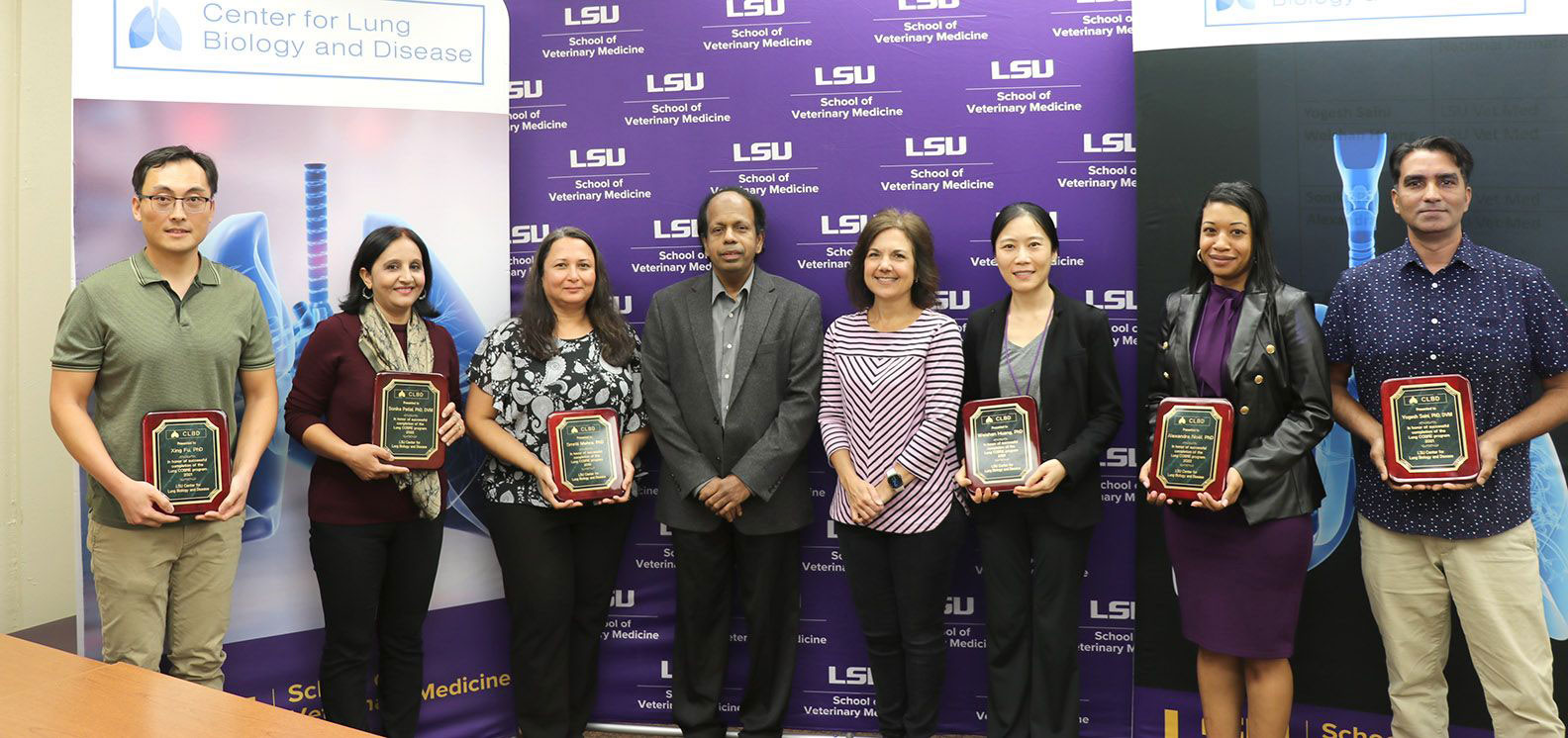
Drs. Xing Fu, Sonika Patial, Smriti Mehra, Samithamby "Jey" Jeyaseelan, Tammy Dugas, Weishan Huang, Alexandra Noël, and Yogesh Saini.
Breath work
Meet the CLBD project investigators and their discoveries-in-progress:
Weishan Huang, PhD (project investigator, LSU Vet Med)
Dr. Huang investigates the influence of genetics and environment on how lung diseases progress and explores new therapies for respiratory viral infections such as flu and COVID-19. She studies host-virus interactions, immune responses to infections and vaccinations, mechanisms of immunopathology, and strategies for preventing and treating respiratory viral infections. Dr. Huang’s research utilizes the interdisciplinary team expertise at the LSU Vet Med and CLBD including immunology, virology, pathology, molecular and cellular biology, bioengineering, and bioinformatics.
Yogesh Saini, DVM, PhD (project investigator, LSU Vet Med)
Dr. Saini’s interdisciplinary research deals with the cellular and molecular mechanisms associated with allergic asthma, ozone-induced airway disease, and secondhand smoke-induced COPD. Patients with asthma develop pulmonary exacerbations due to heightened immune responses. Current treatments, such as corticosteroids, aim to suppress immune responses and thus put these patients in the immunocompromised health status. He looks at the role of macrophages (virus-fighting front-responder cells in the airways of lungs) in asthma outcomes.
Alexandra Noël, PhD (project investigator, LSU Vet Med)
More than 13 million Americans engage in vaping or use of an electronic nicotine delivery system (ENDS). Dr. Noël researches how vaping affects health outcomes. There are few reports concerning vaping during pregnancy and no studies on asthma in prenatally JUUL (e-cigarette)-exposed offspring. Dr. Noël is testing the hypothesis that in utero JUUL exposure causes unfavorable birth outcomes and lasting pulmonary health effects. Research shows that inhalation of JUUL aerosols during pregnancy affects the intrauterine environment, impairs lung development, and heightens the effects of allergic airway responses later in life.
Xing Fu (project investigator, LSU AgCenter)
Fibrosis is common in diseases and injuries of tissues and organs, including heart failure-induced cardiac fibrosis and pulmonary fibrosis. Fibrosis is a disease that results when tissue becomes damaged or scarred. In regenerative tissue, such as skeletal muscle and lung, acute injury-induced fibrosis is usually temporary and resolves spontaneously when regeneration is accomplished. The fate and function of fibroblasts in chronic fibrosis are not very clear. Dr. Fu’s research delineates the mechanisms by which fibroblast proliferation and differentiation activities impact the development of left ventricular heart failure-induced cardiac fibrosis and pulmonary fibrosis.
Chen Chen (project investigator, LSU College of Science)
Staphylococcus aureus-associated pneumonia accounts for about 50,000 infections per year in the U.S. and is one of the leading agents of ventilator-associated pneumonia. S. aureus pneumonia has a high rate of mortality due to antibiotic resistance and lack of an effective vaccine. During pulmonary infection, the neutrophil influx is a double-edged sword: neutrophils clear the invading pathogens, or overzealous neutrophils may cause tissue damage leading to pneumonia. Hence, understanding the mechanisms by which S. aureus keeps lung neutrophils at rest is crucial to decipher how S. aureus maintains its silent colonization state and when/how its presence becomes pathogenic. Dr. Chen’s research focuses on revealing a potential new therapy to treat pneumonia associated with massive neutrophil migration.
Mariano Carossino, DVM, PhD, Dipl. ACVM, Dipl. ACVP (project investigator, LSU Vet Med)
Dr. Carossino studies virus-host interactions during respiratory and persistent viral infections. Obesity and type 2 diabetes affect a large proportion of the U.S. population. Those with these metabolic diseases are at least three times more likely to develop severe COVID-19 or influenza infections necessitating intensive care. Dr. Carossino is focused on dissecting the cellular mechanisms influencing the pathogenicity of viral respiratory infections and driving this increased susceptibility in this at-risk population.
Basel Abuaita, PhD (project investigator, LSU Vet Med)
Antibiotic-resistant Staphylococcus aureus infection is a major public health threat in the lung and extrapulmonary organs. It is unclear whether stress responses aid or impede pulmonary immunity. Dr. Abuaita’s research explores mechanisms by which cellular stress responses in innate immune cells aid in bacterial clearance in the infected lung. Discoveries may reveal new approaches for treating respiratory infections caused by antibiotic-resistant bacteria. The goals are to define how these stress pathways control the function of innate immune cells of the lung and to test whether modulators of these cellular stresses can help to defend the lung against infection.
William Beavers, PhD (project investigator, LSU Vet Med)
Staphylococcus aureus, the leading cause of skin and soft tissue infections, causes over 900,000 severe infections annually in the U.S. It is increasingly resistant to commonly used antibiotics. We define how the host kills S. aureus and how S. aureus avoids killing by the host at the molecular level, focusing on antimicrobial protein post-translational modifications. Taking an interdisciplinary approach, combining analytical chemistry, bacteriology, bacterial pathogenesis, and chemical biology, both in vitro and in vivo, we identify and validate S. aureus therapeutic weaknesses for targeting by the next generation of antimicrobials that will enhance our ability to treat S. aureus infections.
“The lung COBRE grant is working as it was intended. The first generation of lung COBRE scientists are now joining the team as leaders, and they will go on to mentor others,” Dr. Dugas said of a program that, each moment, builds toward discoveries to help people breathe easier.
Rescue dog surprises adopter by saving his life; now she’s blind and gets premium care at LSU Vet Med
By Sandra Sarr
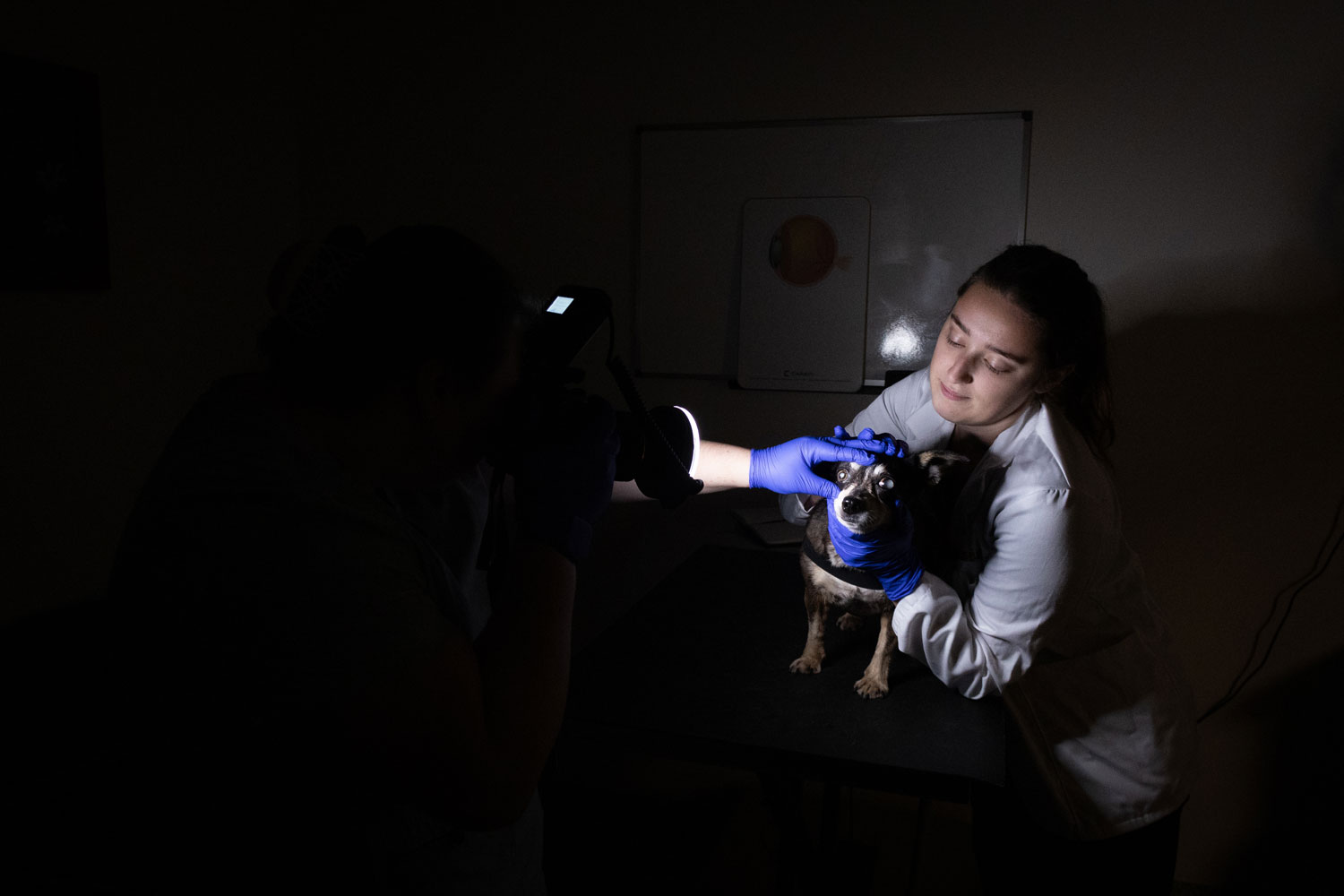
LSU Vet Med Ophthalmology Service client Lynn Ladner got more than he bargained for when he adopted a shelter dog named Chloe eight years ago. All he knew was that he liked the way her ears stuck out in a picture the rescue posted, and so he applied to adopt her. Lynn couldn’t know then that Chloe possessed a superpower that would save his life.
Just 48 hours after Lynn drove the 18-lb. dog home to Gulfport, Miss., from the rescue on the Alabama-Tennessee border, she awakened him in the night by jumping up and down on his chest.
“My first thought was, ‘This dog has gone crazy!’ Then I realized I couldn’t get out of bed. My vision was blurred, I was dizzy, I could barely function. I called 911,” said Lynn, a project manager who does government contract work based out of the NASA Stennis Space Center.
Lynn was experiencing a Type 2 diabetic episode. If Chloe hadn’t awakened him, he was at great risk for a diabetic coma, a life-threatening disorder that causes unconsciousness. Medics arrived and determined his blood sugar had hit an extreme level. They administered insulin, stabilized him, and said of Chloe, “This dog was alerting you to a life-threatening situation.”
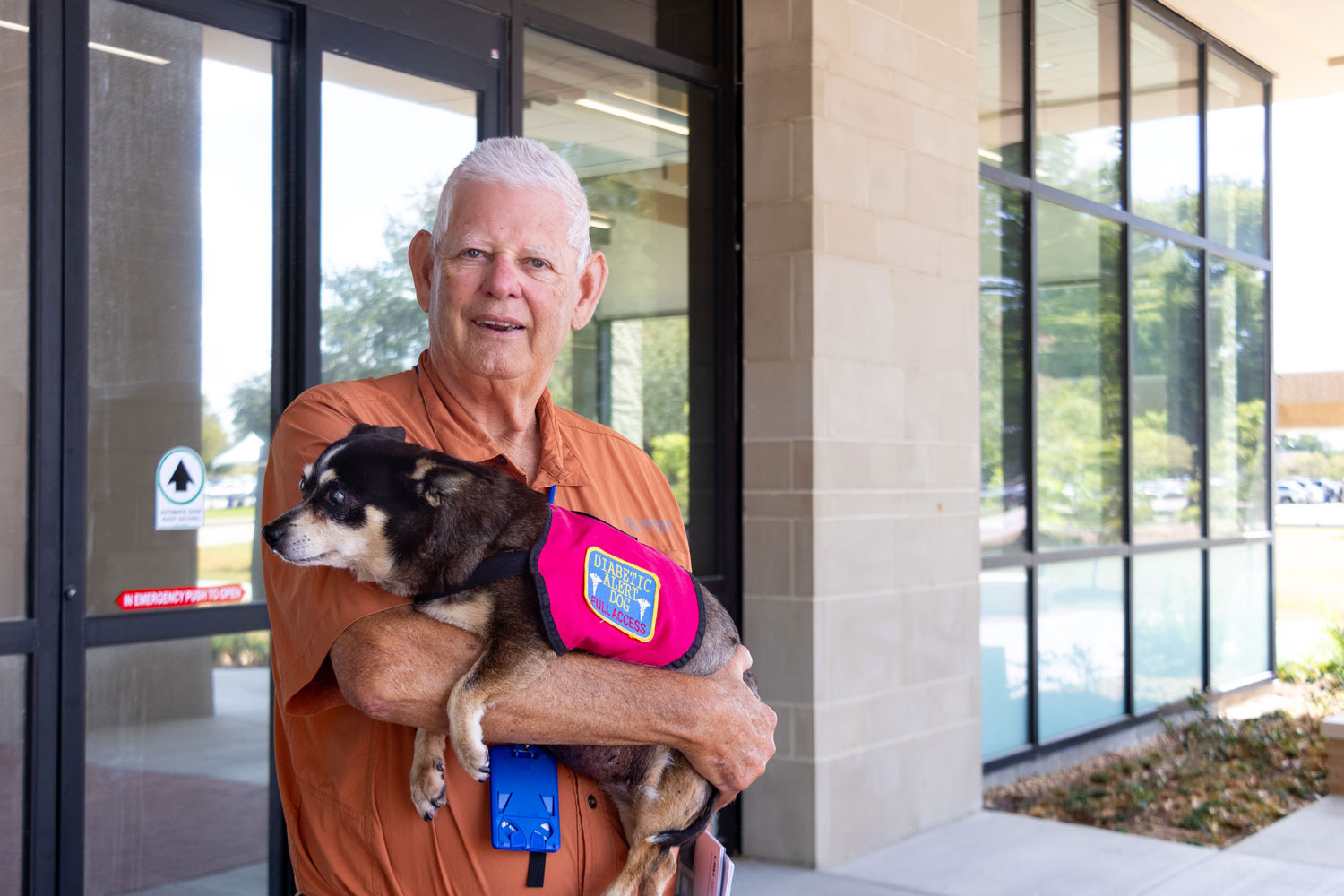
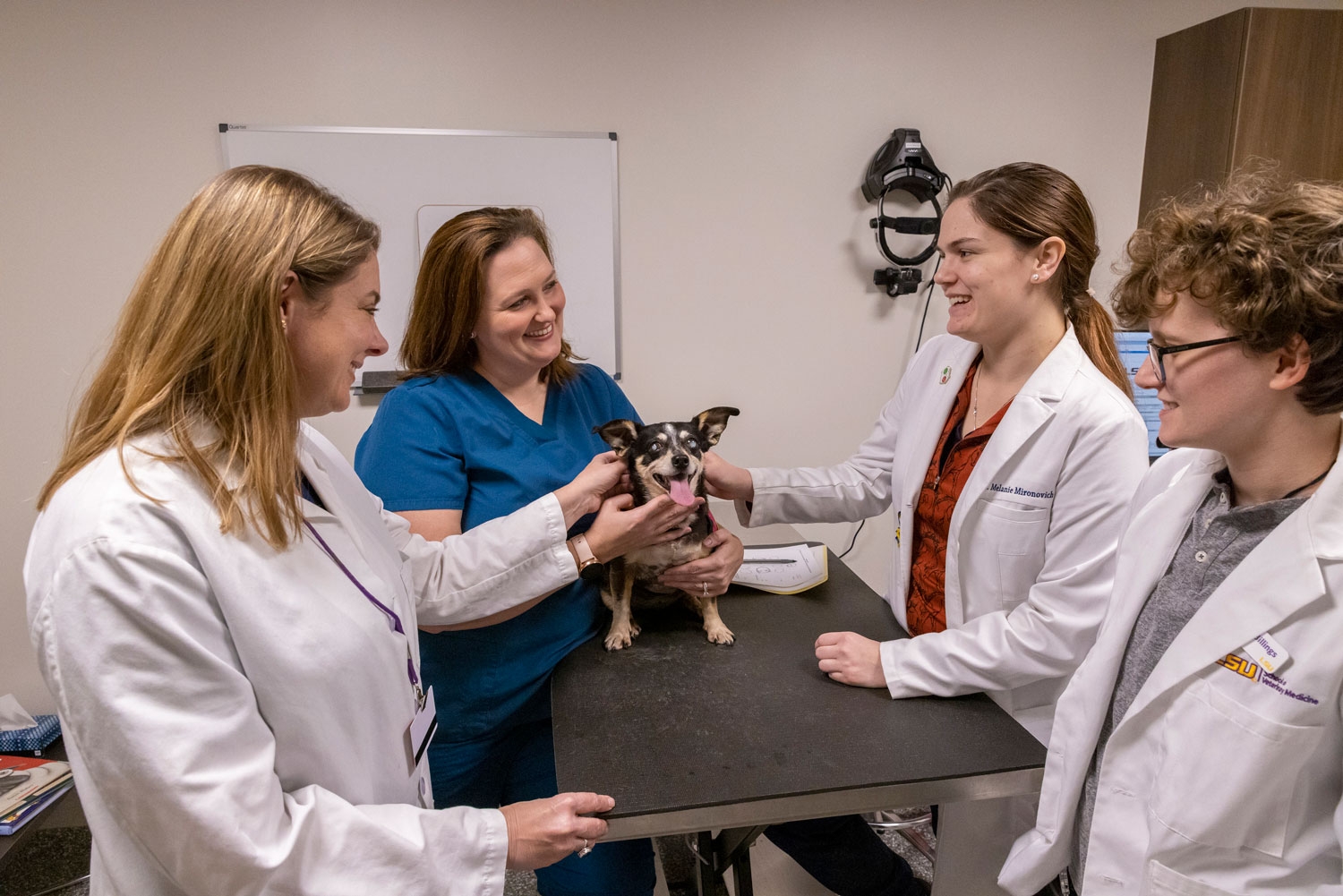
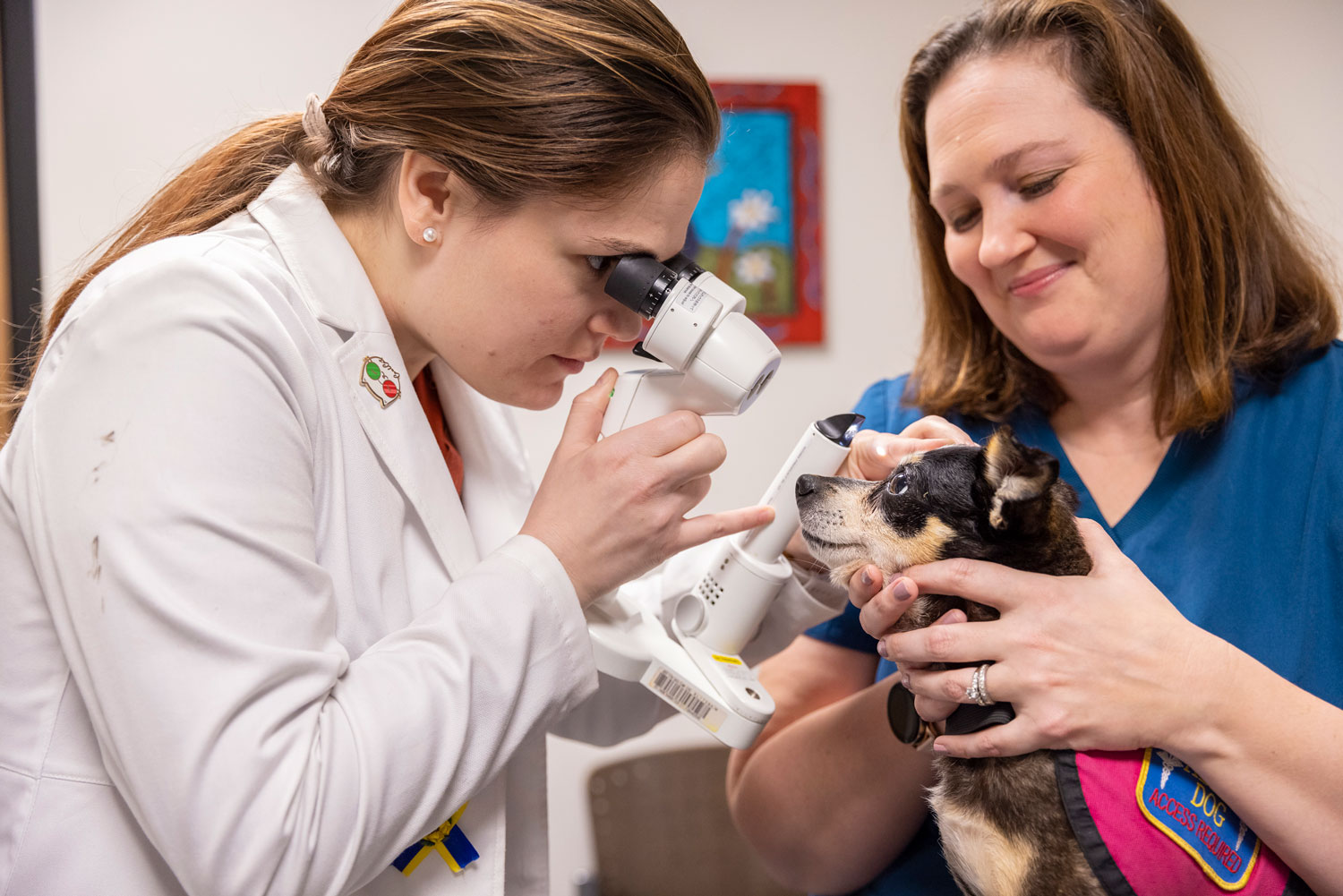
Underdog
“I didn’t even know there were diabetes alert dogs. I’d never heard of such a thing,” Lynn said.
The following morning, Lynn called the rescue where he adopted Chloe and told them what happened.
“I needed to know more about this little dog,” he said.
The rescue put Lynn in touch with Chloe’s former veterinarian, who told him that two-year-old Chloe had been trained as a diabetes support dog for an older woman. When she died shortly thereafter, Chloe went to live with the woman’s daughter whose boyfriend mistreated the dog. A neighbor noticed her plight, intervened, and that’s how Chloe ended up in rescue.
Although alert dogs typically receive extensive training geared toward their diabetic owner’s particular scent, Chloe saved Lynn’s life only 48 hours after they first met.
Diabetes alert dogs typically undergo two years of specialized training preparing them for their working life. Often the trained dog and the diabetic owner will take two or three weeks of additional training together. These dogs, typically Labrador retrievers, golden retrievers, standard poodles, and labradoodles, can range in price from $10,000-$25,000. Lynn paid $200 to the rescue to adopt Chloe, a dachshund-rat terrier mix.
“She saved my life. I’m a very lucky man,” said Lynn, holding Chloe in the waiting room at LSU Vet Med.
They help each other
Now, Lynn does all he can to repay the favor, especially since Chloe, nearly 10, lost her ability to see about a year ago.
Every 90 days, Lynn and Chloe wake up early and head west from their home in Gulfport, Miss., to LSU School of Veterinary Medicine in Baton Rouge, La., where Chloe gets eye check-ups with the Ophthalmology service. They make the five-hour roundtrip as they have for the past four years to have her eyes rechecked and to ensure there is no inflammation or glaucoma.
Chloe was diagnosed with a progressive, inherited disorder known as Progressive Retinal Atrophy or PRA. This condition causes a gradual loss of the photoreceptors or “camera-like” receptors that are present in the retina and important to vision. Over time, patients with PRA unfortunately lose vision in both eyes. Dogs with chronic PRA often develop cataracts and inflammation due to ongoing changes within the eye. Pressures and inflammation have caused Chloe to require long-term medical care for her eyes to keep her comfortable.
Chloe’s eyes need to be regularly monitored after her initial diagnosis and treatment. Given the changes in Chloe’s eyes, daily eye drops are needed. Lynn will make the regular trek to LSU Vet Med and administer eye drops twice a day for the rest of Chloe’s life.
“Chloe is a sweet girl! She has adapted very well to her vision loss and is a true joy to work with. We will continue to work with her and her wonderful family to monitor the health of her eyes and ensure that she remains comfortable,” said Dr. Renee Carter, professor of veterinary ophthalmology.
At home, Lynn helps Chloe adapt to blindness and navigate their space, although she no longer needs much assistance. He puts drops of vanilla on each side of doorways so that she knows how to find the openings.
“She knows where all of the furniture and objects are in the house,” he said.
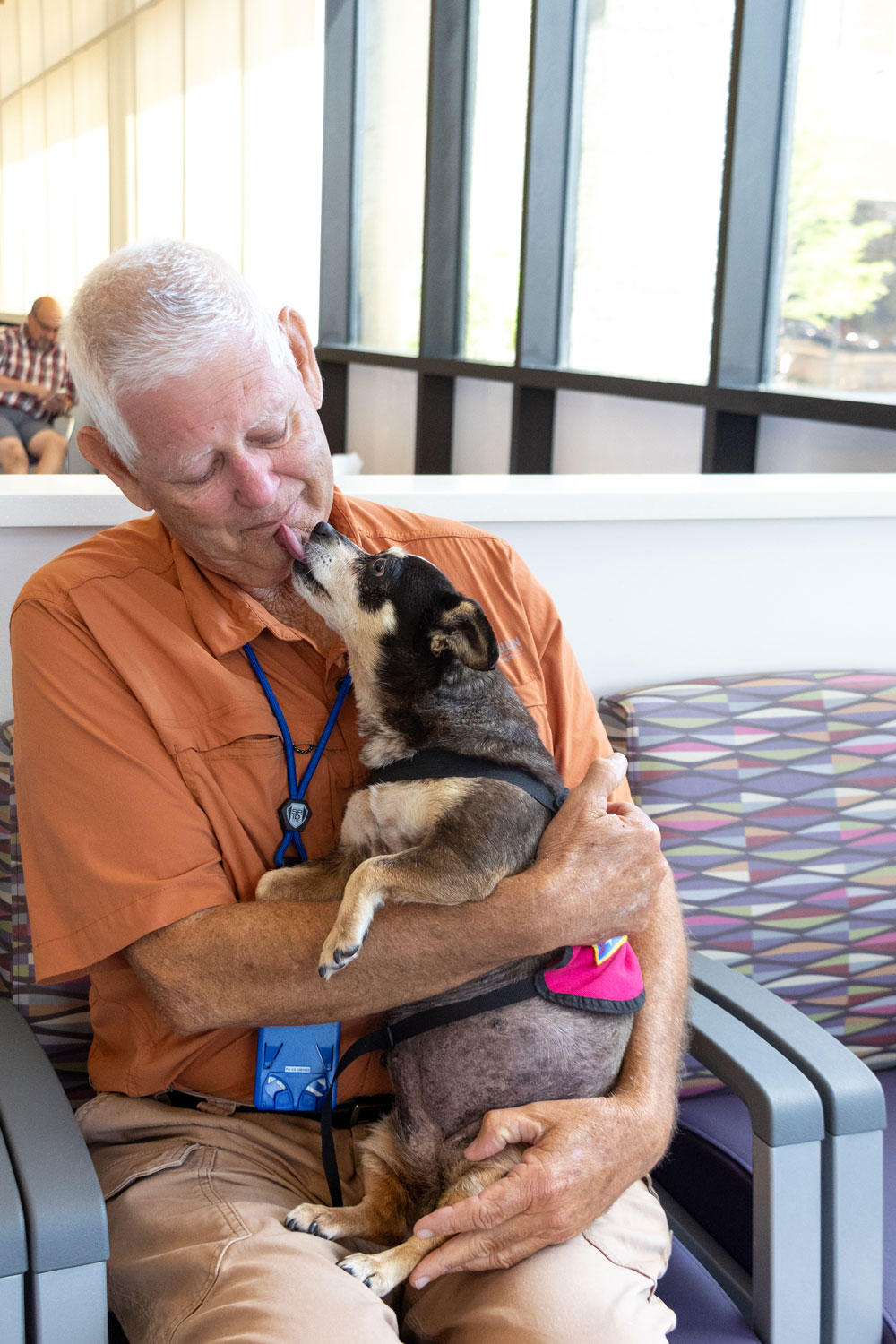
Serious business
Even though she is blind now, the former rescue dog can still perform her medical alert duties for Lynn since she performs them based on her sense of smell.
“She ended up alerting me a second time and kept me safe,” he said.
Chloe stays close and checks Lynn’s breath throughout the day. It’s her job. Diabetes alert dogs are trained to detect blood sugar levels before they become too dangerous. This gives the person time to test and use necessary medication before the blood sugar levels change further.
“Before going into a diabetic coma, your breath has a sweet smell and within 12 hours you can die. I take her everywhere with me. If she can’t be near me, even temporarily, she thinks something bad has happened to me and she gets very agitated,” he said.
Reporting for duty
Chloe has been issued top security clearance to accompany the U.S. Navy veteran at NASA's largest rocket engine test facility, the John C. Stennis Space Center, in Hancock County, Miss. She has also accompanied Lynn to Houston and other work sites.
“The Space Center director knows Chloe and asks about her if I step into a meeting without her. They all love her,” he said.
The small-but-mighty dog has gone where few humans will ever tread, including on test stands where rocket engines are tested before launching into space.
As a diabetes alert dog, Chloe is covered under the Americans with Disabilities Act, a federal law which protects people with disabilities from discrimination. She accompanies Lynn inside restaurants and other public places where dogs are typically forbidden. On rare occasions when staff questions her presence, he shows them a card that describes ADA rights concerning service dogs.
“It’s recommended that service dogs get retrained every few years, but she doesn’t need it,” he said of Chloe, who was attuned to his needs the moment they met.
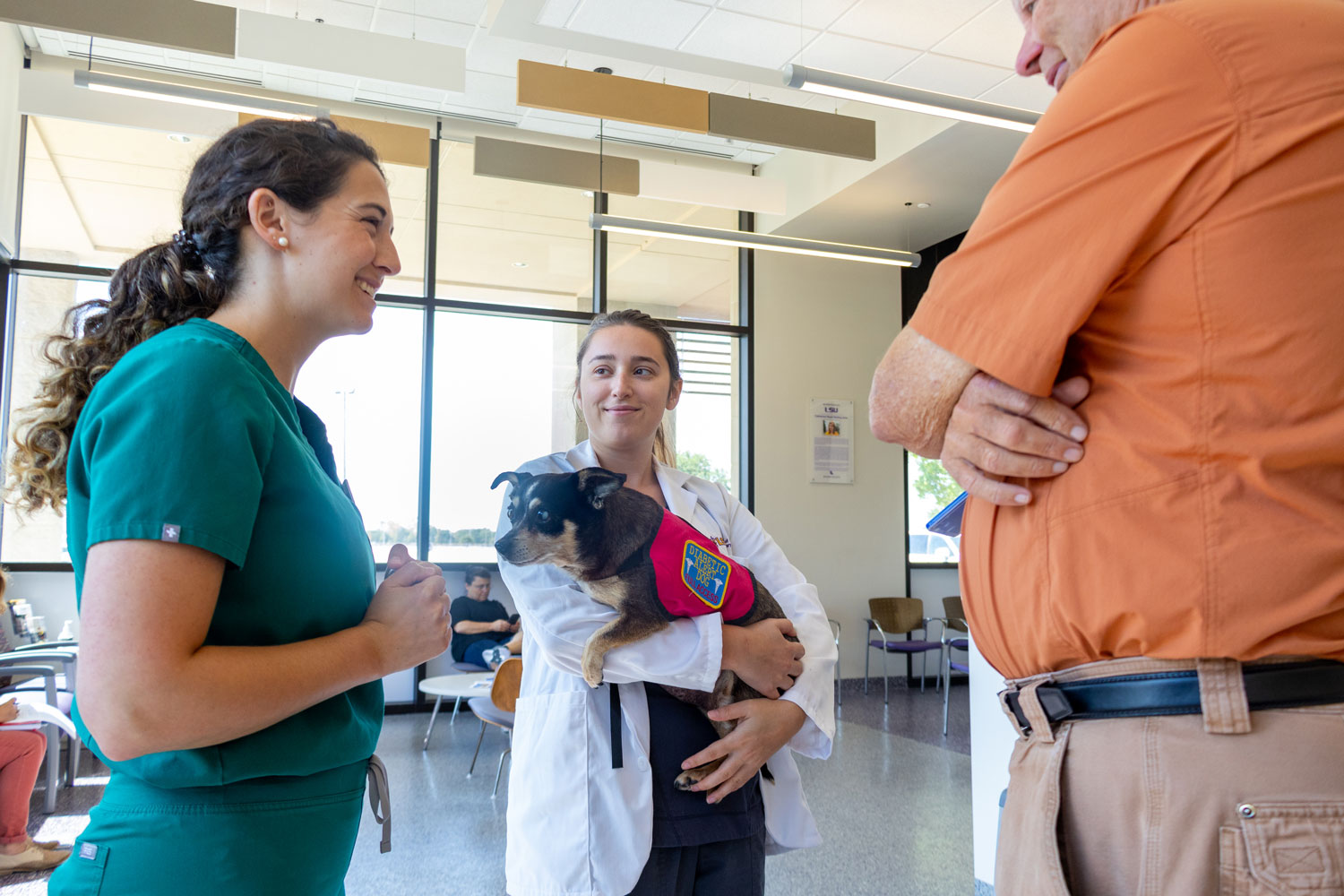
Inseparable
Even though Chloe’s job is serious business, her life is filled with fun, chasing toys, doing dances, and running in the yard with two other dogs. At night, Chloe sleeps on the pillow next to Lynn’s head. “She snores worse than I do,” Lynn said with a laugh.
In the remarkable story of Chloe and Lynn, it’s not about who rescued who. It’s about
the ways in which they can depend on each other in the most important ways going through
life together.
“They take care of each other,” Dr. Carter said.
“We’re inseparable. I don’t know what we would do without each other,” he said.
Visionary expertise
LSU Vet Med Ophthalmology service provides the most current ophthalmic care for patients of all species with precision-specialized equipment and techniques. In addition to the diagnosis and medical treatment of eye diseases, the Ophthalmology Service provides advanced surgical services.
